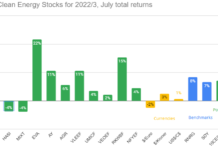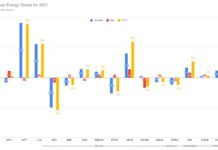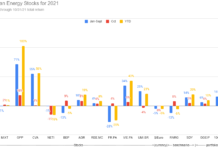Tom Konrad CFA
My Ten Clean Energy Stocks for 2015 model portfolio had a good May, despite headwinds from the strengthening dollar and declines in clean energy stocks in general. As a whole, the model portfolio rose 2.2% for the month, the same as my broad market benchmark. In general, clean energy stocks did worse, with the Powershares Wilderhill Clean Energy ETF (PBW) down 1.9% for the month. The portfolios clean energy benchmark, which blends PBW with the more income oriented Utility ETF, JXI, was flat.
For the year to date, the portfolio is up 7.4%, ahead of all its benchmarks for the first time this year. Their YTD returns were 3.9% for IWM, 7.2% for PBW, 1.4% for the blended benchmark, and -2.5% for JXI.
Income Portfolio Performance and New Benchmark: YLCO
The six-stock income oriented sub-portfolio continues to shine, up 1.9% for the month and 16.5% YTD. The fossil fuel free income oriented portfolio I manage with Green Alpha Advisors, GAGEIP, also continues to do well. It is up 1.5% for the month and 10.2% YTD.
The benchmark for these income portfolios is JXI (up 1.2% for May and down 2.5% YTD), but as I discussed in previous articles, it is an unsatisfactory benchmark because it lacks a clean energy focus. That changed on May 28th, with the launch of the Global X YieldCo Index ETF (NASD:YLCO), which focuses on global income-producing clean energy power producers that pay high dividends. Three of YLCO’s 20 holdings are also in this portfolio TransAlta Renewables Inc. (TSX:RNW, OTC:TRSWF), (Hannon Armstrong Sustainable Infrastructure (NYSE:HASI), and Capstone Infrastructure Corp (TSX:CSE. OTC:MCQPF), but they comprise only 9.2% of YLCO compared to half of the income stocks in my model portfolio.
One of the most important functions of a benchmark is to indicate what part of a portfolio’s return is due to stock selection, as opposed to sector and overall stock market performance. Hence, YLCO is a much better benchmark for a clean energy income portfolio than JXI because it is also focused on income producing clean energy stocks. Going forward, I intend to add YLCO as in income benchmark, and substitute it for JXI in the blended clean energy benchmark for the whole portfolio. I will back-fill performance data for YLCO using JXI for the first five months of the year unless I am able to obtain historical performance information from its underlying Indxx Global YieldCo Index.
Value/Growth Portfolio Performance
The four stock value and growth sub-portfolio gained 2.6% for the month, and now is down 6.2% for the year. This remains far behind its benchmark, PBW, which fell 1.9% for the month but is up 7.2% year to date.
The chart below (click for larger version) gives details of individual stock performance, followed by a discussion of the month’s news for each stock.

The low and high targets given below are my estimates of the range within which I expected each stock to finish 2015 when I compiled the list at the end of 2014.
Income Stocks
1. Hannon Armstrong Sustainable Infrastructure (NYSE:HASI).
12/31/2014 Price: $14.23. Annual Dividend: $1.04. Beta: 0.81. Low Target: $13.50. High Target: $17.
5/29/2015 Price: $20.48. YTD Dividend: $0.52 YTD Total Return: 47.6%.
Sustainable infrastructure financier and Real Estate Investment Trust Hannon Armstrong continues to go from strength to strength. The company released first quarter earnings in line with its previous guidance, growing Core Earnings by 35% over the previous year.
Although I don’t consider HASI overvalued at current prices, I have been selling in my own and managed portfolios for re-balancing. As I wrote many times in 2013 and 2014, I felt it was extremely undervalued in the $10-$13 range in 2013 and 2014. It was my largest position at the start of the year. Now that it’s up almost 50% and more fairly valued, I’m selling to bring it back in line with the rest of my holdings.
Long-time readers who also acquired large stakes below $13 should also consider taking some profits.
The company released its annual Sustainability Report Card. The company estimates “that assets financed by Hannon Armstrong in 2014 will reduce emissions by more than 340,577 metric tons of GHG per year, equivalent to more than 165,000 tons of coal, and save more than 145 million gallons of water annually.” That’s one annual metric ton of GHG saved for every 96 HASI shares, one annual ton of coal saved per 197 HASI shares, and 4.5 annual gallons of water saved per HASI share.
2. General Cable Corp. (NYSE:BGC)
12/31/2014 Price: $14.90. Annual Dividend: $0.72. Beta: 1.54. Low Target: $10. High Target: $30.
5/29/2015 Price: $18.89. YTD Dividend: $0. YTD Total Return: 26.8%.
International manufacturer of electrical and fiber optic cable General Cable Corp. reported strong first quarter results. After adjusting for the sale of some divisions, revenue was up a modest 3% over the same quarter a year earlier, but net profit more than doubled. The company attributes the strength to its restructuring efforts, careful management of working capital, and strong demand for submarine products in Europe.
The company will pay a quarterly dividend of $0.18 on June 26th.
3. TransAlta Renewables Inc. (TSX:RNW, OTC:TRSWF)
12/31/2014 Price: C$11.48. Annual Dividend: C$0.84. Low Target: C$10. High Target: C$15.
5/29/2015 Price: C$12.65. YTD Dividend: C$0.32 YTD Total C$ Return: 13.0%. YTD Total US$ Return: 5.3%.
Yieldco TransAlta Renewables did not advance as much as I expected after increasing its monthly dividend to 7 Canadian cents. I believe its failure to advance was due to rising interest rate expectations in Canada. Rising interest rate expectations tend to hurt all income investments, including yieldcos.
I continue to consider TransAlta Renewables to be very attractively valued at the current price, but no longer like the company as much from an environmental perspective. The acquisition of four natural gas pipelines and a natural gas power station which is currently under development has made TransAlta a lot less “Renewable”. When the gas power station is commissioned, ap
proximately a third of the yieldco’s assets will be transportation or electricity generation from natural gas.
I am currently holding my positions in the company, but intend to sell when the stock is no longer so undervalued.
4. Capstone Infrastructure Corp (TSX:CSE. OTC:MCQPF).
12/31/2014 Price: C$3.20. Annual Dividend C$0.30. Low Target: C$3. High Target: C$5.
5/29/2015 Price: C$3.13. YTD Dividend: C$0.15 YTD Total C$ Return: 2.5%. YTD Total US$ Return: -4.5%.
Canadian power producer and developer (yieldco) Capstone Infrastructure suffered from the same Canadian interest rate expectations as TransAlta Renewables, but did not have a dividend increase to offset that effect.
Revenues fell by 21%, and Adjusted Funds From Operations (AFFO) fell by two-thirds mainly because of the new power contract at Capstone’s Cardinal facility offset by newly commissioned wind farms. The company maintained its full year forecast. AFFO is important because it is management’s estimate of how much money they have available to pay dividends.
In 2013, before the agreement was signed, I made some estimates about its effect on 2015 AFFO.
The actual contract was essentially in line with my lowest estimate, which I predicted would result in a 2015 approximately C$21 million AFFO. First quarter AFFO was C$6.5 million, easily on track to exceed my low prediction, especially with the addition of the Goulais Wind Farm which was commissioned in May and will be contributing to results for the rest of the year.
At the current rate, 2015 dividends are likely to be a little above AFFO, but I expect the dividend to be maintained, despite the fact that the market seems to be pricing in a dividend cut. (The current dividend yield is 9.6%, many analysts feel that anything above 8% indicates expectations for a cut.)
I believe a cut is unlikely for several reasons, starting with company insider’s confidence in the stock. Management has repeatedly said that they intend to maintain the dividend, and they have been buying shares in the public market and not selling any of the shares they receive as part of their compensation. Company insiders would not be buying the stock if they thought there was any likelihood of a dividend cut.

Second, while 2015 AFFO could easily fall below dividends paid, there are many reasons to expect that 2016 will be a much better year. Capstones’ development projects will continue to add incremental AFFO, and more importantly, two more of Ontario’s nuclear reactors will begin refurbishment next year. This this will reduce overall electricity supply and likely lead to periods of higher electricity prices and increased profits at Cardinal. These increased profits will provide extra AFFO to maintain the dividend as Capstone’s development projects are commissioned and increase long run AFFO.
New Flyer Industries (TSX:NFI, OTC:NFYEF).
12/31/2014 Price: C$13.48. Annual Dividend: C$0.62. Low Target: C$10. High Target: C$20.
5/29/2015 Price: C$15.60. YTD Dividend: C$0.25 YTD Total C$ Return: 17.6%. YTD Total US$ Return: 9.6%.
Leading North American bus manufacturer New Flyer also suffered from increasing Canadian interest rate expectations, but these were more than offset when the company announced a surprise dividend increase in conjunction with its first quarter results.
As I’d previously discussed, I was expecting a dividend increase towards the end of the year. From the discussion in the conference call, I get the impression that this will likely be the first of many dividend increases in coming years. New Flyer’s CEO, Paul Soubry, stated “We are not going to disclose our exact formulas and methodologies, but I can tell you that we are now in a methodology of a regular review” of the dividend. This means that as long as the company’s financial performance continues to improve, some of that improvement will flow through to shareholders in the form of increased dividends.
Investors tend to value growing dividends highly, often much more highly than stable dividends. If I am right that his is just the first of many dividend increases, I would expect New Flyer’s stock to increase even more rapidly than the dividend.
6. Accell Group (XAMS:ACCEL, OTC:ACGPF).
12/31/2014 Price: €13.60. Annual Dividend: €0.61. Low Target: €12. High Target: €20.
5/29/2015 Price: €16.66. YTD Dividend: €0.61 YTD Total € Return: 27.0%. YTD Total US$ Return: 14.5%.
Bicycle manufacturer Accell Group did not report any significant news in May, although there was an interesting article about Accell’s leadership in the new and growing category of speed e-bikes in its home country of the Netherlands.
Value Stocks
7. Future Fuel Corp. (NYSE:FF)
12/31/2014 Price: $13.02. Annual Dividend: $0.24. Beta 0.36. Low Target: $10. High Target: $20.
5/29/2015 Price: $12.00 YTD Dividend: $0.06. YTD Total Return: -7.4%.
Ethanol producers are again up in arms about proposed cuts to biofuels mandates in the EPA’s proposed 2014-2016 targets, but renewable diesel producers such as FutureFuel would be “reasonably OK with it,” according to Jim Lane, publisher of Biofuels Digest. Given how bad the EPA’s track record over the last couple years has been, that’s a ringing endorsement.
FutureFuel has not released a statement on the proposal, but Renewable Energy Group’s statement gives some insight. “We are positive about today’s EPA announcement related to proposed biomass-based diesel volumes for 2014-2017 and overall advanced biofuels for 2014-2016. This proposal reduces uncertainty and points towards con
tinuing growth for the near future and beyond. … This is a significant improvement over the original 1.28 billion gallon 2014 [biomass-based diesel] proposal.”
The news came out on Friday, and FutureFuel and a more pure-play biodiesel producer, Renewable Energy Group (NASD:REGI) I also follow were both up on the news, by 3% and 4%. I expect them to climb further next week as the market digests the news.
8. Power REIT (NYSE:PW).
12/31/2014 Price: $8.35. Annual Dividend: $0. Beta: 0.52. Low Target: $5. High Target: $20.
5/29/2015 Price: $5.03. YTD Total Return: -39.8%.
Solar and rail Real Estate Investment Trust Power REIT’s stock continued to decline in the wake of the negative summary judgement I wrote about last month. This decline was partly due to the fact that the few outstanding issues in the case were not resolved, and so the case will go to trial in August.
Most of the legal work on both sides has already been done, so I don’t expect legal expenses to balloon again, and I expect that, even if Power REIT appeals the ruling, it will only do so if expenses can be contained. Hence I maintain my expectation that the dividend will be resumed before the end of 2016, and think the stock will again be a good buy if it falls substantially below $5.
9. Ameresco, Inc. (NASD:AMRC).
12/31/2014 Price: $7.00. Annual Dividend: $0. Beta: 1.36. Low Target: $6. High Target: $16.
5/29/2015 Price: $7.26. YTD Total Return: 3.7%.
Energy service contractor Ameresco released strong first quarter earnings, again beating analyst estimates for the third quarter in a row. The company continues to see recovery, especially in the Federal market. Ameresco is also reducing its risk profile by developing renewable assets which it keeps on its books. The resulting depreciation reduces income in the short term, but leads to long term stable income streams.
These positive developments have not yet drawn significant investor attention and the stock price remains low. Company insiders, on the other hand, are taking advantage by continuing to add to their positions. Four different insiders have bought a total of 265,000 shares over the last three months.
Growth Stock
10. MiX Telematics Limited (NASD:MIXT).
12/31/2014 Price: $6.50. Annual Dividend: $0. Beta: 0.78. Low Target: $5. High Target: $20.
5/29/2015 Price: $7.70. YTD Dividend: $0. YTD Total South African Rand Return: 27.0%. YTD Total US$ Return: 18.5%.
Vehicle and fleet management software-as-a-service provider MiX Telematics also announced quarterly results on Thursday, as well as annual results for its fiscal year, which ends on March 31st. The company resoundingly beat the consensus earnings estimate (14¢ vs. 7¢ per share) and was very upbeat about its opportunities in the North American market.
The stock has rallied strongly since the announcement, but given its massive undervaluation, I think there is still plenty of room to the upside.
Predictions for June
Last month, I thought TransAlta Renewables and MiX Telematics had the best chance of short term gains. TransAlta’s dividend increase produced only a small (2%) advance in Canadian dollar terms, but this was wiped out by the strong US dollar, leading to a small loss of 1.2% since last month. MiX’s strong earnings, on the other hand, helped to push its stock up 12.3% in terms of the South African Rand, which was reduced to 10% for US investors because of the strong dollar.
So my perfect track record of predicting five out of five monthly winners in previous updates was broken by TransAlta’s slight decline. The record is now 6 out of 7. But given that MiX’s advance was much larger than TransAlta’s decline, I’m happy with the result and willing to stick my neck out again.
I don’t expect much news as we move into the slow summer months, so price moves should be driven mostly by valuation. I’m quite bullish on all four of TransAlta, Capstone, FutureFuel, and MiX right now, but given MiX’s recent advance, I think that it may give back some gains in the short term. Hence I’m going to limit my prediction for June advances to just the first three: TRSWF, MCQPF, and FF.
Disclosure: Long HASI, CSE/MCQPF, ACCEL/ACGPF, NFI/NFYEF, AMRC, MIXT, PW, PW-PA, FF, BGC, RNW/TRSWF, REGI. I am the co-manager of the GAGEIP strategy.
DISCLAIMER: Past performance is not a guarantee or a reliable indicator of future results. This article contains the current opinions of the author and such opinions are subject to change without notice. This article has been distributed for informational purposes only. Forecasts, estimates, and certain information contained herein should not be considered as investment advice or a recommendation of any particular security, strategy or investment product. Information contained herein has been obtained from sources believed to be reliable, but not guaranteed.








could you please explain the tax structure for Capstone Infrastructure? I don’t know how this works in Canada. Is it like an MLP? Is the tax regime sustainable? Also do you mention anything about Capstone’s debt in any of your posts? thank you for any insights.
Capstone is a corporation and is taxed as such.
Capstone has more than the average amount of debt compared to its peers, which is part of the reason it has such a high yield.